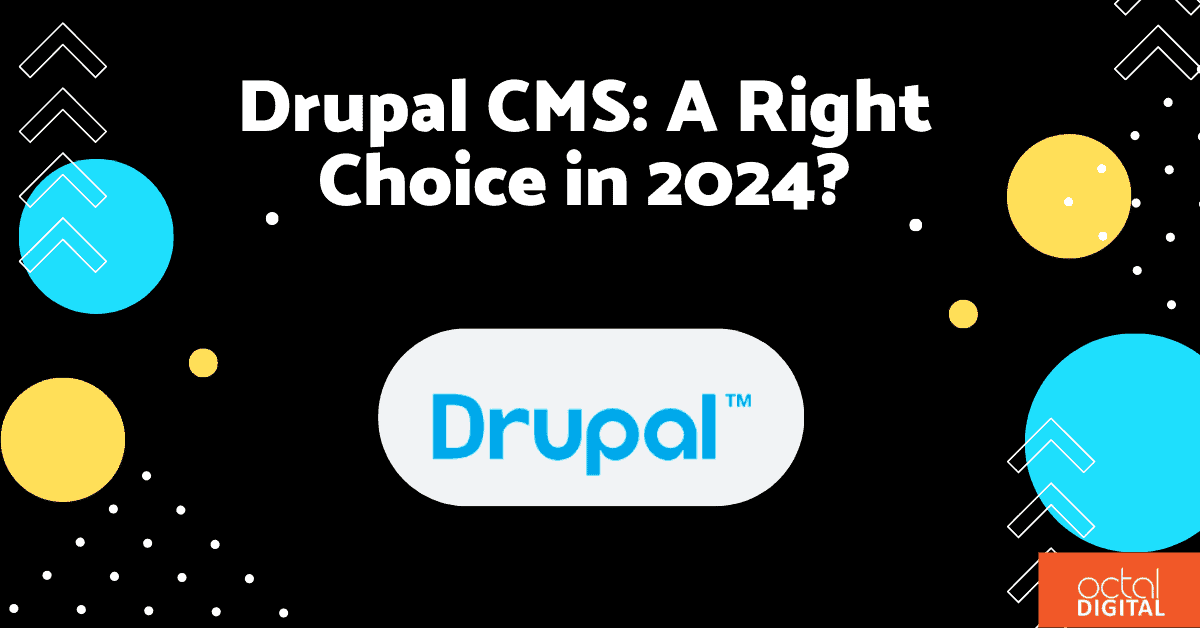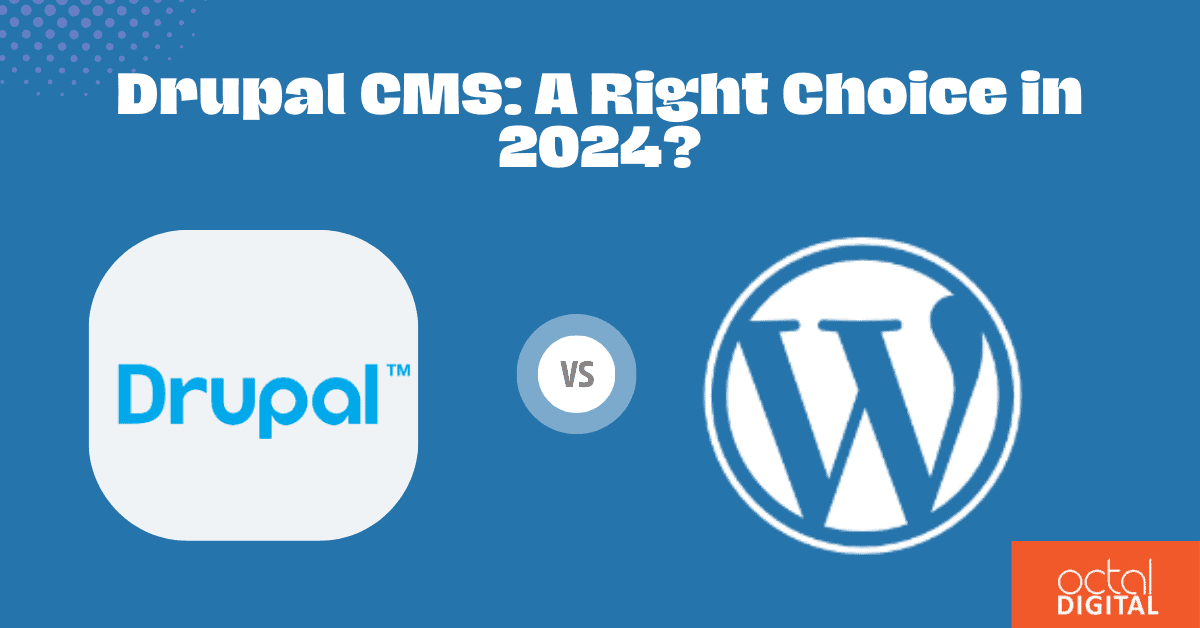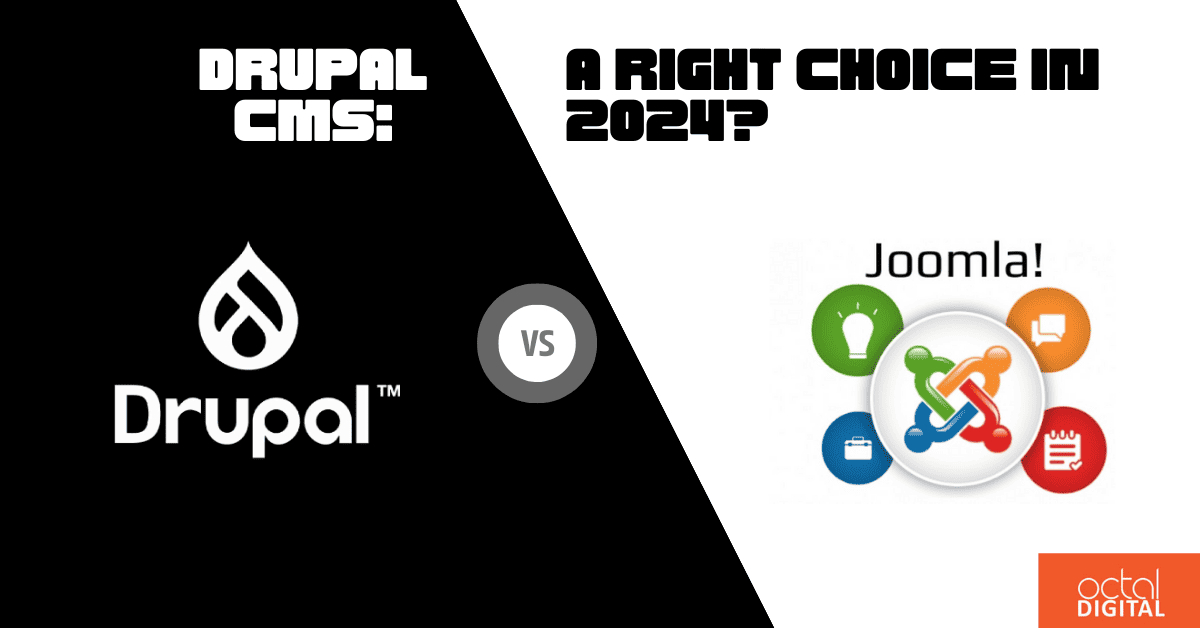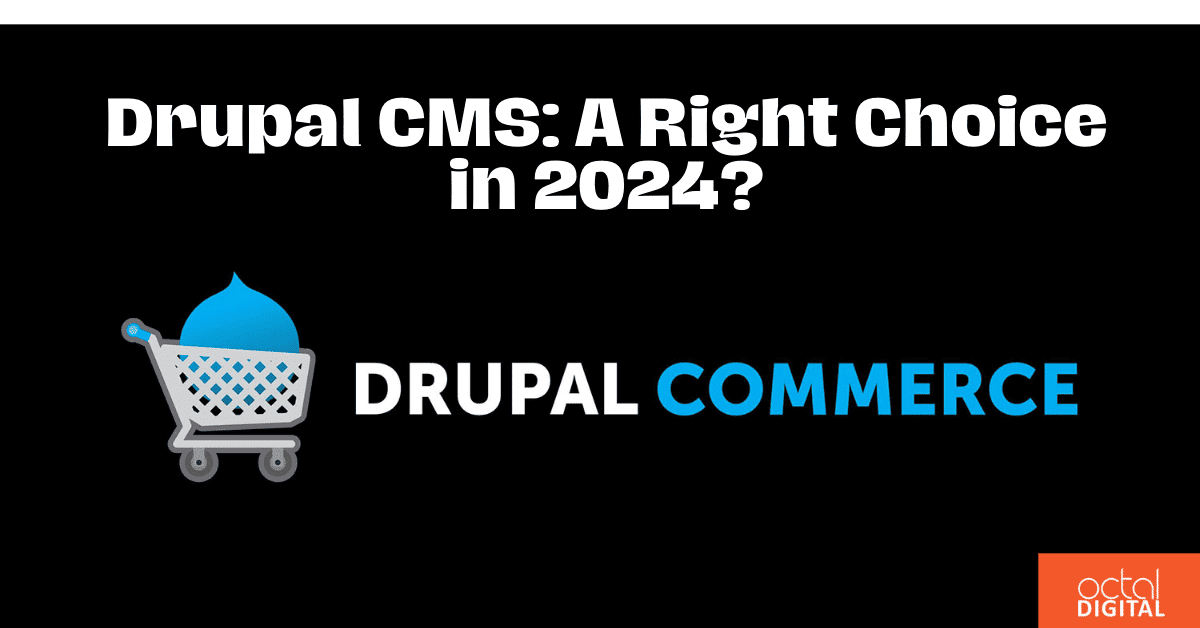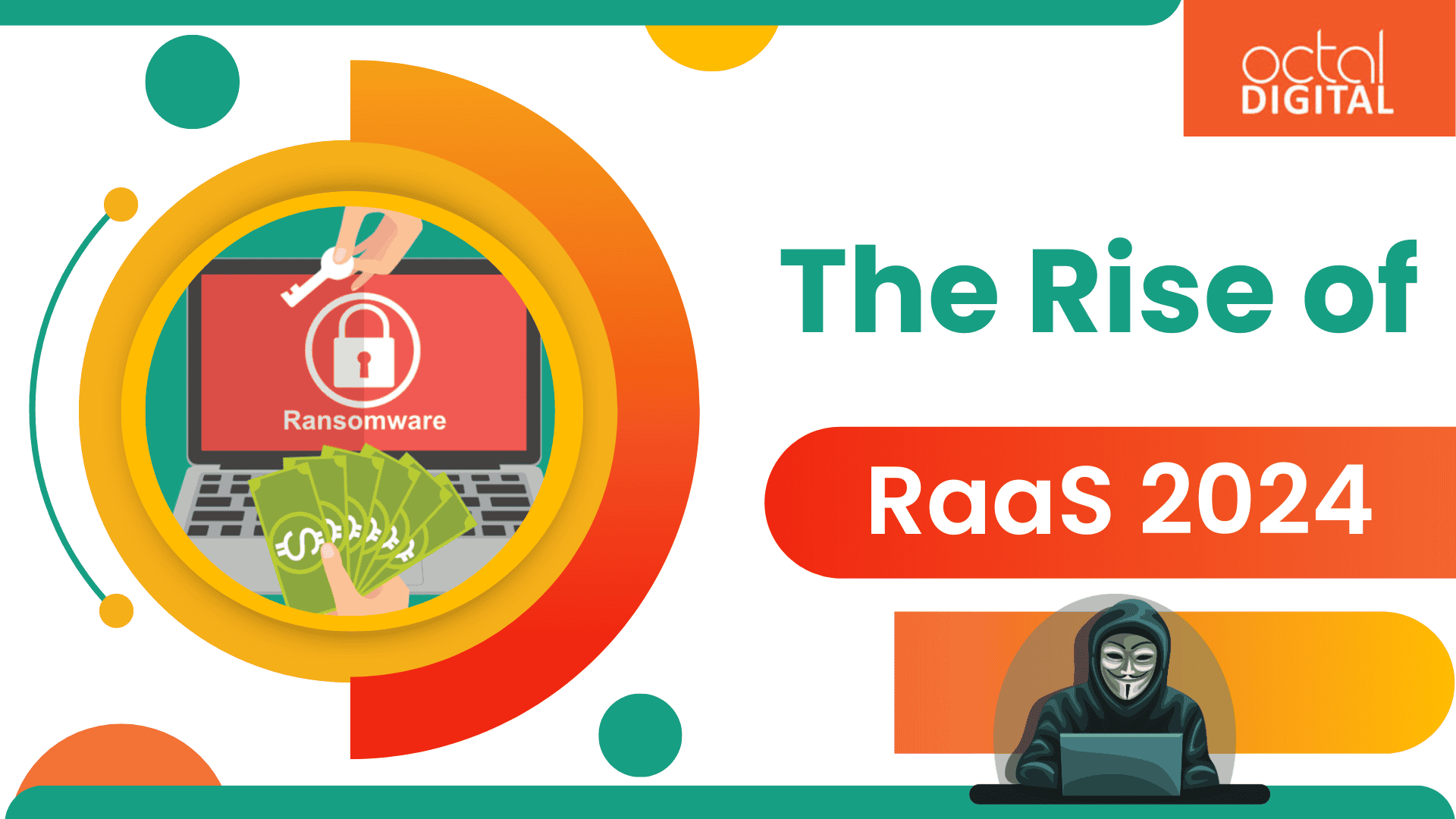Selecting the right Content Management System (CMS) is paramount for developers seeking optimal functionality, scalability, and security. This article delves into the technical intricacies of Drupal (CMS), positioning it as a powerhouse in comparison to WordPress and Joomla. From modular architecture to security features, we will explore the technical aspects that answer our question, “Drupal CMS: A Right Choice in 2024?”.
Side By Side Comparison: Drupal v.s. WordPress v.s. Joomla
| Technical Aspect | Drupal | WordPress | Joomla |
| Architecture | Modular architecture based on Symfony components | Monolithic architecture with themes and plugins | Traditional architecture with a focus on simplicity |
| Theming Engine | Twig templating engine for dynamic and responsive designs | PHP-based theming with template hierarchy | PHP-based theming with a focus on simplicity |
| Security Features | Dedicated Security Team, robust permission system, proactive updates | Active security community, extensive use of plugins introduces potential vulnerabilities | Dedicated security team, regular security updates |
| Content Modeling | Entity-based content model for complex data structures | Custom post types and taxonomies for content organization | Structured content with categories and articles |
| API Integration | Robust RESTful APIs and web services for third-party integration | RESTful APIs with limited native support for headless architectures | Limited native support for APIs and headless architectures |
| E-commerce Capabilities | Drupal Commerce provides modular and customizable e-commerce solutions | WooCommerce and plugins for e-commerce functionalities | VirtueMart and extensions for e-commerce features |
| Developer Community | Large and active community with extensive resources and modules | Large community with a vast plugin repository | Dedicated community, but smaller compared to Drupal and WordPress |
| Coding Standards | Emphasis on adherence to Drupal Coding Standards for consistency and maintainability | Adherence to WordPress Coding Standards, but varied coding practices due to plugins | Adherence to Joomla Coding Standards for consistency |
| Performance Optimization | Features like BigPipe, Dynamic Page Cache, and integration with CDNs | Caching mechanisms, but may rely on plugins for optimization | Caching mechanisms and limited native optimization features |
| Customization Flexibility | Highly customizable with a vast repository of modules and themes | Customizable with a diverse range of plugins and themes | Customizable with extensions and templates |
| Community Support | A vibrant community with regular meetups and events, a strong knowledge-sharing culture | Active community with forums, tutorials, and extensive documentation | Dedicated community with support forums and resources |
| Enterprise-level Capabilities | Scalable for complex enterprise solutions with extensive module support | Suited for smaller to mid-sized projects; may require additional plugins for enterprise features | Capable for mid-sized enterprises; extensions may be required for specific functionalities |
Drupal vs WordPress: A Technical Face-off
A. Architecture and Flexibility
1. Drupal’s Modular Architecture
Drupal’s technical prowess lies in its modular architecture, leveraging Symfony components. This structure facilitates the creation of custom modules, each encapsulating specific functionalities. Symfony’s adherence to Object-Oriented Programming (OOP) principles enhances maintainability, extensibility, and code reusability, critical aspects for complex web development projects.
2. Twig Templating Engine for Theming
Drupal’s theming capabilities are driven by the Twig templating engine. Twig ensures a clear separation of concerns between PHP logic and HTML presentation. Its syntax, resembling natural language, not only enhances developer productivity but also fosters a more intuitive understanding of template structures. This, combined with Drupal’s responsive design capabilities, provides a solid foundation for crafting dynamic and visually appealing user interfaces.
3. WordPress’s Simplicity and Customization Limitations
While WordPress excels in user-friendliness, its theming approach relies on PHP templates. This simplicity may suffice for basic projects, but it falls short of providing the flexibility and scalability required for intricate web applications. In contrast, Drupal’s Twig-based theming system empowers developers to create intricate designs without sacrificing maintainability.
Read More: How To Improve the Shopify Website Security?
B. Security Features
1. Drupal’s Robust Security Features
Security is a linchpin in Drupal’s development philosophy. The CMS employs a Secure Coding Framework that encompasses best practices, coding standards, and continuous security audits. Drupal’s dedicated Security Team actively monitors and addresses vulnerabilities, ensuring that core and contributed modules are fortified against potential threats. The comprehensive permission system, coupled with regular security updates, establishes Drupal as a secure foundation for web applications.
2. WordPress Vulnerabilities and Risks Associated with Plugins
WordPress’s popularity makes it a target for security threats, particularly through third-party plugins. While plugins extend functionality, they can introduce vulnerabilities if not rigorously maintained. Drupal’s security-first approach, stringent coding standards, and vigilant community reduce the risk of security breaches. The emphasis on minimizing the attack surface and continuous security enhancements solidify Drupal’s position as a secure CMS.
Drupal vs Joomla: A Technical Analysis
A. Codebase and Architecture
1. Drupal’s Entity-Based Architecture
Drupal’s entity-based architecture stands in stark contrast to Joomla’s more traditional approach. Entities, representing various content types, provide a powerful and flexible foundation for developers. The entity-based model, coupled with Drupal’s fieldable entities, allows for the creation of intricate data structures, providing developers with unparalleled control over content modeling.
2. Joomla’s Traditional Approach and Simplicity
Joomla, while a robust CMS, follows a more traditional architecture. It employs a simpler object-oriented framework, which may appeal to those seeking a straightforward solution. However, this simplicity comes with limitations in terms of customization and extensibility, especially when compared to Drupal’s more modular and flexible entity-based architecture.
B. Community and Development Ecosystem
1. Drupal’s Extensive Community Resources
Drupal’s large and active community is a major differentiator. The community-driven development model ensures a continuous influx of new ideas, improvements, and solutions. The vast repository of contributed modules, themes, and documentation further enriches the development ecosystem. This extensive support network is instrumental in addressing challenges, sharing knowledge, and propelling Drupal’s evolution.
2. Joomla’s Dedicated Community and Potential Limitations
Joomla boasts a dedicated community that actively contributes to its development. However, the scale and resources of the Joomla community may not match the vastness of Drupal’s ecosystem. This can potentially limit the availability of resources, third-party extensions, and the breadth of expertise, impacting the overall depth of the development ecosystem.
Looking for a team to make your online presence? Octal Digital, offers years of expertise in digital services in Houston.
Drupal CMS: Unleashing Development Practices
A. Modularity and Extensibility
1. Entity-Based Content Model
Drupal’s entity-based content model is a cornerstone of its flexibility. Entities, representing content elements like nodes or taxonomy terms, provide a structured and extensible way to organize and manage information. This model allows developers to create complex data relationships within the CMS, offering unparalleled flexibility when designing content structures for diverse projects.
2. Extensive Module Repository and Custom Module Development
The strength of Drupal’s modularity is exemplified by its extensive module repository. Developers can choose from a plethora of pre-built modules to enhance functionality or opt for custom module development when unique requirements arise. The hook system, a fundamental part of Drupal’s architecture, enables seamless integration of custom code, offering a level of extensibility that caters to the specific needs of each project.
B. API Integration
1. Robust APIs for Seamless Third-Party Integration
Drupal’s RESTful APIs and web services support open the gateway to seamless third-party integration. The decoupled nature of Drupal allows developers to create headless architectures, where the CMS serves as a content repository. This facilitates a flexible approach where front-end technologies can be chosen independently, ensuring optimal performance and adaptability to emerging development trends.
2. Support for Headless Architectures
Drupal’s API-first approach aligns with the demands of modern web development. By supporting headless architectures, Drupal empowers developers to decouple the back end from the front end, enabling the use of diverse front-end technologies. This flexibility not only enhances the developer’s toolkit but also future-proofs projects, ensuring they remain adaptable in the face of evolving technological landscapes.
Read More: How WebSocket Technology is Revolutionalizing in 2024
Drupal Developers: The Architects of Innovation
A. Coding Standards and Best Practices
1. Importance of Drupal Coding Standards
Drupal’s emphasis on coding standards is a testament to its commitment to clean, maintainable, and secure code. Adhering to the Drupal Coding Standards ensures consistency across projects, simplifying collaboration and code reviews. Consistent coding practices also contribute to a reduced learning curve for developers moving between different Drupal projects.
2. Tools Like Composer and Git for Development
Drupal embraces modern development tools such as Composer for dependency management and Git for version control. Composer streamlines the inclusion of external libraries and modules, promoting modular development practices. Git’s version control capabilities provide a robust foundation for collaboration, enabling developers to work concurrently on different aspects of a project without compromising code integrity.
B. Community and Support
1. Active Community and Knowledge-Sharing
Drupal’s vibrant community is a valuable resource for developers. Regular meetups, forums, and events foster knowledge-sharing and collaboration. The Drupal community’s commitment to inclusivity ensures that developers of all skill levels can benefit from shared experiences, troubleshooting, and innovative solutions to common challenges.
2. Drupal Association’s Initiatives for Developer Support
The Drupal Association plays a pivotal role in supporting developers through initiatives like DrupalCon and community grants. DrupalCon, a global event, provides a platform for developers to engage with industry leaders, attend workshops, and stay abreast of the latest developments. Community grants further support local Drupal initiatives, contributing to a rich ecosystem of knowledge and expertise.
C. Success Examples:
- The Economist: The Economist, a globally recognized publication, utilizes Drupal to power its digital platform. Drupal’s flexibility allows The Economist to deliver content across various channels, providing a seamless and engaging user experience.
- NASA’s Web Presence: NASA employs Drupal for several of its web properties, including the websites for the Mars Rover mission. Drupal’s robustness and scalability make it a suitable choice for managing and presenting complex scientific information.
- Warner Music Group: Warner Music Group, a major player in the music industry, relies on Drupal for its artist websites and content management needs. Drupal’s ability to handle diverse content types and integrate with various services aligns well with the dynamic nature of the music industry.
- Weather.com: The Weather Channel’s website, Weather.com, utilizes Drupal for its content management and presentation. Drupal’s capabilities in handling large amounts of data and providing real-time updates contribute to the success of a site that relies heavily on dynamic content.
- Tesla: Tesla, a leading electric vehicle and clean energy company, uses Drupal for its website. Drupal’s scalability and flexibility allow Tesla to showcase its innovative products, provide detailed information to users, and maintain an engaging online presence.
- Johnson & Johnson: The global healthcare company, Johnson & Johnson, relies on Drupal for its corporate website. Drupal’s ability to handle diverse content types and provide a secure platform aligns with the company’s need to communicate effectively with a wide audience, including investors, healthcare professionals, and consumers.
- Georgia.gov: The official website for the state of Georgia, Georgia.gov, is built on Drupal. Drupal’s scalability and content flexibility enable the state government to provide citizens with access to information, services, and resources in a structured and user-friendly manner.
- Acquia: Acquia, a company that provides cloud-based solutions for Drupal, exemplifies the business success of the Drupal ecosystem. Acquia’s offerings, including hosting, support, and optimization services, cater to businesses looking to maximize the benefits of Drupal for their web presence.
Drupal Commerce: Crafting E-commerce Excellence
A. Commerce Module Ecosystem
1. Modular and Customizable Approach
Drupal Commerce extends Drupal’s capabilities into the e-commerce domain through a modular and customizable approach. The Commerce module ecosystem offers a range of extensions for handling diverse e-commerce requirements, from product variations to complex pricing structures. This modular design allows developers to tailor the shopping experience precisely to the needs of the business.
2. Integration of Payment Gateways, Shipping Methods, and Product Variations
Drupal Commerce excels in providing seamless integrations with payment gateways, shipping methods, and diverse product variations. Its architecture allows developers to integrate third-party services and build custom solutions for specific business needs. The result is a scalable and flexible e-commerce platform capable of meeting the demands of a dynamic online marketplace.
Read More: 10 Best AI Apps for iPhone and Android in 2024
Drupal Web Development: Crafting the Digital Experience
A. Theming and Front-end Development
1. Twig Theming System for Responsive Designs
Drupal’s theming capabilities are elevated by the Twig templating engine. Twig’s syntax simplifies the creation of dynamic and responsive designs, ensuring a consistent and visually appealing user experience across devices. Developers can leverage Twig’s template inheritance, macros, and filters to streamline the theming process, fostering maintainability and code readability.
2. Integration of CSS Preprocessors like SASS and LESS
Drupal empowers front-end developers by integrating CSS preprocessors like SASS and LESS into its theming workflow. This allows for the creation of modular and maintainable stylesheets. By using features such as variables, mixins, and nested rules, developers can efficiently organize and manage styles, facilitating a more streamlined and scalable front-end development process.
B. Performance Optimization
1. Features like BigPipe and Dynamic Page Cache
Drupal’s commitment to performance optimization is evident through features like BigPipe and Dynamic Page Cache. BigPipe, a front-end optimization technique, delivers content in multiple chunks, enhancing perceived performance. The Dynamic Page Cache stores fully rendered HTML pages, reducing server load and accelerating page load times. These features collectively contribute to an optimized user experience and improved search engine rankings.
2. Integration of CDNs and Caching Strategies
Drupal’s flexibility extends to performance optimization through the integration of Content Delivery Networks (CDNs) and caching strategies. CDNs distribute static assets globally, reducing latency and improving load times for users across the globe. Additionally, Drupal’s caching mechanisms, including the Internal Page Cache and external caching solutions like Varnish, further enhance performance by minimizing server response times.
A good Website is complimented by a great app! Get a quote today!
Drupal Web Development: Choosing the Right Team
A. Expertise in the Drupal Ecosystem
1. Importance of Choosing a Drupal-Focused Development Company
Selecting the right Drupal web development company ensures access to a team well-versed in the nuances of Drupal development. The expertise extends beyond basic implementation, encompassing best practices, module selection, and performance optimization. A specialized Drupal team is equipped to navigate the intricacies of the CMS, ensuring efficient development and a robust final product.
2. Access to a Team of Drupal Experts
A Drupal-focused web development company should boast teams of experts specializing in various facets of Drupal development, including theming, module development, and performance optimization. This collective expertise ensures that projects are executed with precision, adhere to coding standards, and leverage the full potential of Drupal’s capabilities.
B. Customization and Integration Services
1. Tailored Solutions for Specific Project Requirements
Drupal web development company should excel in providing tailored solutions to meet specific project requirements. Whether it’s custom module development, theming, or integration with third-party services, one must leverage their expertise to craft solutions that align seamlessly with the project’s goals. This customization ensures that each Drupal-powered website is unique and optimized for its intended purpose.
2. Expertise in API Integrations and Third-Party Services
The proficiency of Drupal web development extends to API integrations and the seamless incorporation of third-party services. From social media integrations to complex external data sources, Drupal’s API-first approach should be oriented towards creating cohesive and integrated web solutions. This expertise ensures a smooth and efficient user experience, even in projects with diverse external dependencies.
Conclusion
In the realm of web development, Drupal emerges as a powerhouse for developers seeking a robust, scalable, and secure platform. Its modular architecture, adherence to coding standards, and active community make it a top choice for projects ranging from simple websites to complex enterprise solutions. While WordPress and Joomla have their merits, Drupal’s technical prowess positions it as a preferred choice for developers aiming to craft innovative and scalable web experiences.
As the digital landscape evolves, Drupal stands resilient, continuously adapting to the dynamic needs of developers and pushing the boundaries of web development excellence. Choosing Drupal means embracing a platform that not only meets the technical demands of today but also lays the foundation for the challenges and opportunities that tomorrow may bring.
FAQ’s
-
What is the difference between Drupal and WordPress?
Drupal and WordPress are both popular content management systems (CMS), but they differ in their architecture and use cases. Drupal is known for its robust and flexible modular architecture, making it suitable for complex and scalable websites. It excels in handling diverse content types and providing extensive customization options. On the other hand, WordPress is renowned for its user-friendly interface and ease of use, making it ideal for smaller websites, blogs, and those with simpler content management needs. The choice between Drupal and WordPress often depends on the complexity of the project and the level of customization required.
-
Is Drupal only for large enterprises, or can it be used for smaller projects?
While Drupal is often associated with large enterprise solutions due to its scalability and flexibility, it is equally suitable for smaller projects. Drupal’s modular architecture allows businesses of all sizes to tailor the CMS to their specific needs. Small businesses and startups can benefit from Drupal’s robust features, security, and extensibility without the need for complex configurations. The key is to assess the project requirements and choose the features that align with the goals of the website or application, ensuring that Drupal provides the necessary foundation for growth and customization.
-
Is Drupal difficult to learn for someone with limited coding experience?
The learning curve for Drupal can vary based on individual experience and background. While Drupal does require some level of technical understanding, particularly for more advanced customization and module development, it is designed to be user-friendly for content editors and administrators. For those with limited coding experience, there might be a steeper initial learning curve, especially if diving into aspects like module development. However, Drupal offers a wealth of documentation, tutorials, and an active community that can assist beginners. Additionally, the availability of pre-built themes and modules simplifies website setup and management, making it accessible for users with varying levels of technical expertise.
